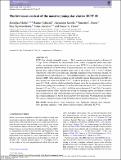The low-mass content of the massive young star cluster RCW 38
Abstract
RCW 38 is a deeply embedded young (∼1 Myr), massive star cluster located at a distance of 1.7 kpc. Twice as dense as the Orion nebula cluster, orders of magnitude denser than other nearby star-forming regions and rich in massive stars, RCW 38 is an ideal place to look for potential differences in brown dwarf formation efficiency as a function of environment. We present deep, high-resolution adaptive optics data of the central ∼0.5 × 0.5 pc2 obtained with NACO at the Very Large Telescope. Through comparison with evolutionary models, we determine masses and extinction for ∼480 candidate members, and derive the first initial mass function (IMF) of the cluster extending into the substellar regime. Representing the IMF as a set of power laws in the form dN/dM ∝ M−α, we derive the slope α = 1.60 ± 0.13 for the mass range 0.5–20 M⊙,which is shallower than the Salpeter slope, but in agreement with results in several other young massive clusters. At the low-mass side, we find α = 0.71 ± 0.11 for masses between 0.02 and 0.5 M⊙, or α = 0.81 ± 0.08 for masses between 0.02 and 1 M⊙. Our result is in agreement with the values found in other young star-forming regions, revealing no evidence that a combination of high stellar densities and the presence of numerous massive stars affects the formation efficiency of brown dwarfs and very-low-mass stars. We estimate that the Milky Way galaxy contains between 25 and 100 billion brown dwarfs (with masses >0.03 M⊙).
Citation
Mužić , K , Schödel , R , Scholz , A , Geers , V C , Jayawardhana , R , Ascenso , J & Cieza , L A 2017 , ' The low-mass content of the massive young star cluster RCW 38 ' , Monthly Notices of the Royal Astronomical Society , vol. 471 , no. 3 , pp. 3699-3712 . https://doi.org/10.1093/mnras/stx1906
Publication
Monthly Notices of the Royal Astronomical Society
Status
Peer reviewed
ISSN
0035-8711Type
Journal article
Description
KM acknowledges funding by the Joint Committee of ESO/Government of Chile, and by the Science and Technology Foundation of Portugal (FCT), grant no. IF/00194/2015. Part of the research leading to these results has received funding from the European Research Council under the European Union’s Seventh Framework Programme (FP7/2007-2013)/ERC grant agreement no. [614922]. RJ acknowledges support from NSERC grants. JA acknowledges funding by the Science and Technology Foundation of Portugal (FCT), grant no. SFRH/BPD/101562/2014.Collections
Items in the St Andrews Research Repository are protected by copyright, with all rights reserved, unless otherwise indicated.

